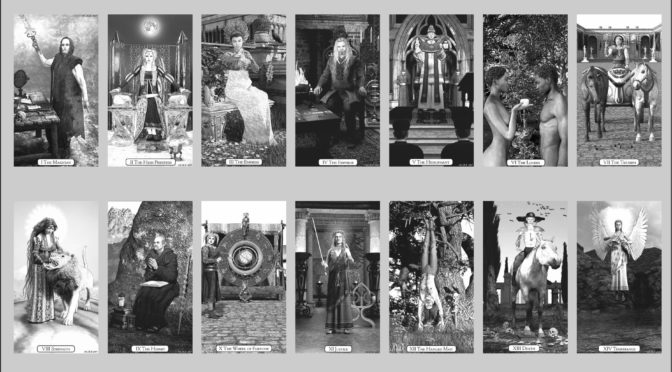I have released Playing the Fool to Amazon and it should become available to buy in the US, UK and EU domains within the next few days.
It has taken me just over a year to write and it has been an enormous task. The illustrations alone – 22 Trumps, 16 court cards, etc. – comprised a huge amount of work, and there was not a moment when I did not worship Pamela Colman Smith, who produced her complete and enduring pack in nine months. As for the text, I wrote it out by hand in a little notebook. It poured out as fast as I could write while sitting in coffee shops, pubs, campsites and anywhere else that suited the mood.
The raw material was very colloquial, and it was at that point that I intervened and insisted that the cards ‘talk proper’ – and over time, they did. I read all of Shakespeare as an adolescent, and some residue of the rhythm of sixteenth-century English crept into their speech. As a complement to the text I made a study of Renaissance book design and in particular, a resurgence of interest that occurred in the late 19th century in connection with book designers such as William Morris. Morris (and others) designed typefaces based on Renaissance (so-called Venetian) typefaces, and I thought it would be both fun and appropriate to have a book on Tarot produced in an accessible pastiche of Renaissance style.
I had originally hoped to produce something in the style of the famous Hypnerotomachia Poliphili but my illustrations were more formal than the woodcut art of that seminal text, and what you find is a compromise. However, that book was always at the back of my mind, as were the pseudo-Tarot woodcuts found in the fictional De Umbrarum Regni Novem Portis (seen in the film The Ninth Gate). I was also very influenced by a splendid volume of the Divine Comedy illustrated by Gustave Doré that I read as a student, and if you notice any vague correspondence between the adventures of the Fool, and Dante’s journey through Inferno, Purgatorio and Paradiso, then I doubt that it is accidental 🙂
What is it about? The Tarot cards appear to mirror many aspects of the world of the Renaissance in which they first appeared. The Fool (who has ‘no place’ in the original numbered sequence of Trumps) is ideally suited to explore this mirror world, and so she does, meeting all the Trump and Court cards, and she discovers rich relationships between the cards.
The book is filled with period detail and esoteric lore mined from Kabbalah and the Hermetic tradition, and I hope you will enjoy it. The Fool insisted that it should all be fun. And I hope that it is.
[PS: Ah, you say, the Fool is a young man! But not this Fool, and if you demand a respectable reason, I can tell you that Folly in Latin, stultitia, is a noun of feminine gender, and so she appears in the early sixteenth century In Praise of Folly written by Desiderius Erasmus.]
STOP PRESS: see http://www.digital-brilliance.com/publications/index.php for publication details.

